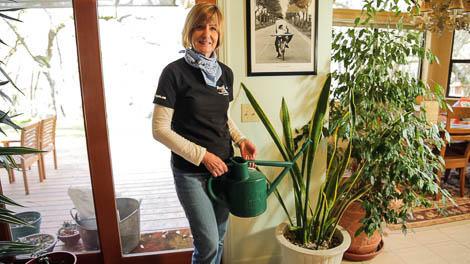It's really quite simple to apply your "outdoor" organic gardening knowledge to your house plants.
Who doesn't want a lush mass of greenery inside during the winter months? When the seasons shift, many house plants can head outside with you to enoy the fresh breezes of summer.
Be an organic gardener without setting foot out of the house
It's time to reexamine your indoor gardening skills, and take a new look at your go-to products for dealing with any pests or diseases. In our video, Tricia leaves her raised beds behind and takes us on a tour of her house plants. She explains organic gardening basics for these tender plants, from soil on through light, fertilizer, watering, pest and disease control. You can make your interior, organic garden thrive, with common sense (and a moisture meter). It's easy too -- no cover crops, double-digging, or bird netting.
IPM moves inside
Use the principles of IPM (Integrated Pest Management) indoors. Remember the IPM acronym for year-round plant care -- PAMS? The "A" is for avoidance, as in "avoid inviting pests home". Inspect that house plant before you buy it. If you don't inspect, you could be walking in the front door of your house with a gang of mealybugs. They won't just decimate your new plant -- they'll enjoy themselves all over your other house plants too. Same goes for "avoiding" plant diseases. Restrain yourself from taking pity on a withering plant in a dark corner of the store. While you're happily playing Florence Nightingale with the sick plant, the disease might be spreading to your cherished indoor plants. "P" is for prevention, which means keeping the soil moist enough for happy roots, but not so moist that it will attract pests. If you do get critters like fungus gnats, try adding a Gnat Stix for Houseplants. Add a tonic of micronutrients to your plants by foliar feeding them with one of our staff favorites, Peaceful Valley Organic Liquid Kelp. We apply it with handheld sprayers. Pump the top of the spray container and then just hold it while it does all the spraying work -- no repetitive motion needed. The "M" of monitoring means you look for pests or diseases. Remove them by hand or with a damp cloth (as Tricia tackles scale in the video), or by spraying Safer EndAll Insect Killer, which is labeled for use on most house plants, but read the label for any sensitive plants and the pests that it is labeled to control.
Best bets in house plants
 To get the latest scoop on house plants we went to the authors of a new book on the topic. Garden pros Kylee Baumle and Jenny Peterson's Indoor Plant Décor: The Design Stylebook for Houseplants. We asked Kylee and Jenny for two separate Top Ten lists: popular plants and easy-care plants. Of course, we were most interested in the plants that made both lists.
To get the latest scoop on house plants we went to the authors of a new book on the topic. Garden pros Kylee Baumle and Jenny Peterson's Indoor Plant Décor: The Design Stylebook for Houseplants. We asked Kylee and Jenny for two separate Top Ten lists: popular plants and easy-care plants. Of course, we were most interested in the plants that made both lists. 
Must grows -- easy care, popular house plants
Tricia is admiring her dracaena, which is on both the popular and easy care lists. Other house plants that landed in this special group are pothos, philodendron, jade plant, and the new-to-us ZZ plant (Zamioculcas zamiifolia). 
Plants that are worth a bit of trouble
African violets, for instance, might need coddling, but once you get them near the proper window they'll bloom and bloom. Orchids, ferns, and some palms have unusual needs that you can meet with organic methods. 
Easy care house plants that will stand by you
The peace lily wants water, and then some more water, but it will hang in with you for years. Other troupers that Kylee and Jenny recommend are spider plant, cacti, Chinese evergreen, ponytail palm, and Tricia's snake plant. Many of these toughies can clean the air for you too. Ready to plant indoors? Start a succulent container garden right now.
Garden without your rubber boots or your wheelbarrow. Your house plants will love you for using organic pest and disease control, and you'll have a healthier home.
Dealing with stink bugs in your garden or orchard? These pests can be tough to manage once they move in. Browse our full line of stink bug treatments and insecticides to find effective solutions for prevention and control.

